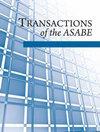生态系统保护地表水农药暴露评价研究进展
IF 1.4
4区 农林科学
Q3 AGRICULTURAL ENGINEERING
引用次数: 4
摘要
强调作物保护和病虫害管理方案仍然是现代粮食生产的组成部分。必须评估农药的潜在生态影响,并采取关键的缓解做法。需要努力推动地表水农药暴露评估从田间到景观尺度。确保有效的农药缓解措施需要量化动态的特定地点特征。生态评估必须改善对不利人群和社区结果的预测。摘要随着全球粮食需求的增加,农药的使用将继续增加,低收入和中等收入国家的农药使用量将显著增加。使用农药的农业系统是复杂的,具有重要且往往未知的生物、人类和物理化学相互作用。这些相互作用包括气候和水文、土壤类型、最佳管理实践的选择和使用、化学品命运和运输、应用技术和土地利用社会经济学。这篇综述文章的目的是强调从最近关于推进农药接触评估和缓解的特别会议和讲习班中确定的关键研究机会。需要研究使用先进的分析和取证,以便通过新的监测和检测来更好地了解农药在环境中的分布。更高层次的建模方法可以帮助为先验监测提供信息,以更好地表征环境中的农药分布。目前的农药暴露评估主要集中在田间或流域尺度上,但需要向能够分析相互作用的生态系统的景观尺度分析方向发展。评估复杂的低剂量化学混合物对非目标水生生物的影响必须采用新的定量高通量实验方法,重点是确定相互作用,而不仅仅是加性效应。现场缓解措施目前被认为是使用定性、固定效率型方法进行农药接触和风险评估过程的一部分,但我们特别呼吁继续使用现有的定量工具。这些机械建模和模拟工具可以捕捉农业生态系统内在的复杂性。作为与环境有关的设想的一部分,有必要对人口和社区一级的影响进行风险评估,使其更具预测性。最后,专业协会必须在促进生物和农业工程师与其他学科的跨学科合作方面发挥更积极的作用,以促进生态风险评估的进步。本文章由计算机程序翻译,如有差异,请以英文原文为准。
Advancing Surface Water Pesticide Exposure Assessments for Ecosystem Protection
Highlights Crop protection and pest management programs continue to be integral for modern food production. Potential ecological impacts of pesticides must be assessed, and key mitigation practices adopted. Efforts are needed to advance surface water pesticide exposure assessments from field to landscape scales. Ensuring effective pesticide mitigation practices requires quantifying dynamic site-specific characteristics. Ecological assessments must improve prediction of adverse population and community-level outcomes. Abstract. As the global food demand increases, the use of pesticides will continue to increase with significant growth in low- and middle-income countries. Agricultural systems in which pesticides are used are complex with significant and often unknown biological, human, and physical-chemical interactions. These interactions include climate and hydrology, soil type, selection and use of best management practices, chemical fate and transport, application technology, and land use socioeconomics. The objective of this review article is to highlight key research opportunities identified from recent special meetings and workshops on advancing pesticide exposure assessments and mitigation. Research is needed in using advanced analytics and forensics to better understand the distribution of pesticides in the environment through novel monitoring and detection. Higher-tier modeling approaches can help inform monitoring a priori to better characterize pesticide distributions in the environment. Current pesticide exposure assessments are largely focused on the field or watershed scale, but advancements are needed to move toward landscape-scale analyses capable of analyzing for interacting ecosystems. Assessing the effects of complex, low-dose chemical mixtures on non-target aquatic organisms must advance with new quantitative high-throughput experimental methods focused on identifying interactions and not just additive effects. Field mitigation measures are currently considered as part of the pesticide exposure and risk assessment process using qualitative, fixed-efficiency type approaches, but we specifically call for the use of existing quantitative tools moving forward. These mechanistic modeling and simulation tools can capture the inherent complexity within an agroecological system. There is a need for risk assessment to be more predictive of population and community-level impacts as part of environmentally relevant scenarios. Finally, it is imperative that professional societies take a more proactive role in promoting the transdisciplinary collaboration of biological and agricultural engineers with other disciplines contributing to advances in ecological risk assessment.
求助全文
通过发布文献求助,成功后即可免费获取论文全文。
去求助
来源期刊

Transactions of the ASABE
AGRICULTURAL ENGINEERING-
CiteScore
2.30
自引率
0.00%
发文量
0
审稿时长
6 months
期刊介绍:
This peer-reviewed journal publishes research that advances the engineering of agricultural, food, and biological systems. Submissions must include original data, analysis or design, or synthesis of existing information; research information for the improvement of education, design, construction, or manufacturing practice; or significant and convincing evidence that confirms and strengthens the findings of others or that revises ideas or challenges accepted theory.
 求助内容:
求助内容: 应助结果提醒方式:
应助结果提醒方式:


